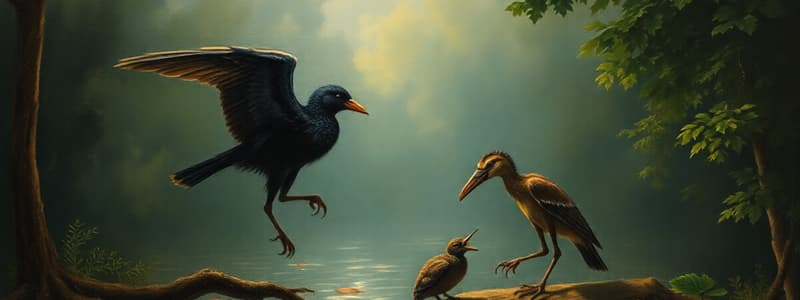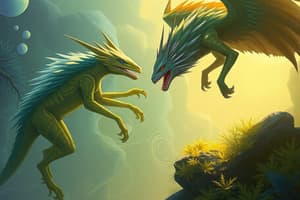Podcast
Questions and Answers
What does the term 'niche' refer to in ecology?
What does the term 'niche' refer to in ecology?
- The total number of individuals in a community.
- The habitat in which a species resides.
- The competition between two species for resources.
- The role a species plays in an ecosystem. (correct)
Which aspect describes the 'realized niche' of a species?
Which aspect describes the 'realized niche' of a species?
- The total population size of a species within an ecosystem.
- The exclusive habitat required by a species.
- The potential environmental conditions a species could occupy.
- The actual environment a species inhabits considering interactions. (correct)
Which of the following statements accurately reflects the 'Rule of Ten' in ecology?
Which of the following statements accurately reflects the 'Rule of Ten' in ecology?
- Ten percent of a species' population can survive in competition.
- Ten percent of biomass is transferred to the next trophic level.
- Approximately ten percent of energy from primary producers is available to primary consumers. (correct)
- Only ten percent of energy is lost between each trophic level.
What is the significance of 'keystone species' in community ecology?
What is the significance of 'keystone species' in community ecology?
What did Charles Elton introduce in relation to species interactions?
What did Charles Elton introduce in relation to species interactions?
How do otters contribute to the maintenance of kelp ecosystems?
How do otters contribute to the maintenance of kelp ecosystems?
What is meant by 'trophic cascades' in an ecosystem?
What is meant by 'trophic cascades' in an ecosystem?
What approach is primarily used in biocontrol to manage pest species?
What approach is primarily used in biocontrol to manage pest species?
What was the outcome of introducing the Cactoblastis Moth to Australia?
What was the outcome of introducing the Cactoblastis Moth to Australia?
What was a consequence of introducing the cane toad to Australia?
What was a consequence of introducing the cane toad to Australia?
What type of interaction occurs when both species are negatively impacted?
What type of interaction occurs when both species are negatively impacted?
Which statement best describes herbivory?
Which statement best describes herbivory?
What is the primary difference between predation and parasitism?
What is the primary difference between predation and parasitism?
How do generalist species behave as they move higher in the food web?
How do generalist species behave as they move higher in the food web?
What does the term 'competitive exclusion' refer to?
What does the term 'competitive exclusion' refer to?
Which of the following is an example of positive species interaction?
Which of the following is an example of positive species interaction?
In the context of species interactions, what is resource partitioning?
In the context of species interactions, what is resource partitioning?
Which interaction is characterized by one organism benefiting while the other is harmed, yet the harmed organism remains alive?
Which interaction is characterized by one organism benefiting while the other is harmed, yet the harmed organism remains alive?
What term describes the interaction where one species benefits while the other is unaffected?
What term describes the interaction where one species benefits while the other is unaffected?
Which of the following best describes an ecosystem engineer?
Which of the following best describes an ecosystem engineer?
What are keystone species known for in an ecosystem?
What are keystone species known for in an ecosystem?
Which of the following factors is NOT a reason for shaping food webs?
Which of the following factors is NOT a reason for shaping food webs?
What role do nitrogen-fixing plants play in ecological interactions?
What role do nitrogen-fixing plants play in ecological interactions?
Why is the concept of trophic relationships important in ecology?
Why is the concept of trophic relationships important in ecology?
Which of the following is the primary consequence of losing a keystone species?
Which of the following is the primary consequence of losing a keystone species?
What is one effect of termites acting as ecosystem engineers?
What is one effect of termites acting as ecosystem engineers?
Flashcards
Ecological Niche
Ecological Niche
biotic and abiotic conditions required for a species to exist and the role a species plays in an ecosystem
Fundamental Niche
Fundamental Niche
The range of conditions that a species could potentially occupy based on its physiological needs and tolerances.
Realized Niche
Realized Niche
The actual range of conditions that a species occupies in its environment, taking into account factors like competition and predation.
Trophic Level
Trophic Level
Signup and view all the flashcards
Rule of Ten
Rule of Ten
Signup and view all the flashcards
Species Interactions
Species Interactions
Signup and view all the flashcards
Predation and Herbivory
Predation and Herbivory
Signup and view all the flashcards
Parasitism
Parasitism
Signup and view all the flashcards
Interspecific Competition
Interspecific Competition
Signup and view all the flashcards
Competitive Exclusion Principle
Competitive Exclusion Principle
Signup and view all the flashcards
Resource Partitioning
Resource Partitioning
Signup and view all the flashcards
Mutualism
Mutualism
Signup and view all the flashcards
Facilitation
Facilitation
Signup and view all the flashcards
Commensalism
Commensalism
Signup and view all the flashcards
Keystone Species
Keystone Species
Signup and view all the flashcards
Ecosystem Engineer
Ecosystem Engineer
Signup and view all the flashcards
Food Webs
Food Webs
Signup and view all the flashcards
Trophic Cascade
Trophic Cascade
Signup and view all the flashcards
Biocontrol
Biocontrol
Signup and view all the flashcards
Biocontrol Methods
Biocontrol Methods
Signup and view all the flashcards
Introduced Species for Biocontrol
Introduced Species for Biocontrol
Signup and view all the flashcards
Biocontrol Gone Wrong
Biocontrol Gone Wrong
Signup and view all the flashcards
Study Notes
Species Interactions
- Species interactions can be negative, positive, or neutral.
- In some interactions, both species are negatively impacted or use energy.
- Predation and herbivory are examples of (+/-) interactions. Predators typically kill prey. Herbivory, while not always deadly, can reduce a plant's fitness (growth and reproduction).
- Predator preferences are often related to prey proportions in the environment.
Parasitism
- Parasitism is a (+/-) interaction. A parasite consumes part or all of a host, but the host does not always die.
- Examples include malaria, parasitic wasps, lice, leeches, and mistletoe.
Competition
- Competition is a (-/-) interaction, meaning both species suffer.
- Competition occurs when species share limited resources. This can involve both biotic and abiotic resources.
- Exploitation competition happens through the shared resources. Interference competition is when one species restricts access.
Competitive Exclusion
- Niche is defined by the biotic and abiotic conditions required for a species to exist, and its role within an ecosystem.
- Some species are better at utilizing resources than others through competitive exclusion.
- Resource partitioning prevents competitive exclusion as species occupy different niches.
Mutualism
- Mutualism is a (+/+) interaction. The relationship is beneficial to both species.
- Seed dispersal and pollination are examples.
- Mitochondria is an example of mutualism at the cellular level.
Commensalism
- Commensalism is a (+/0) interaction. One species benefits while the other isn't affected.
- Coral and other associated species, trees providing habitat are examples.
- Ecosystem engineers are species that influence their surroundings for the benefit of other species.
Facilitation
- Facilitation is an interaction in which one species benefits from the presence and altered environment of another.
- Nitrogen fixing plants in close proximity to other plants illustrate this interaction.
Food Webs
- Food webs are a complex network of organisms depicting their interactions of who eats whom.
- Food webs are formed from species relationships and can be more complex than the trophic "pyramid" model. Trophic pyramids show biomass, energy, and structure, but cannot show all the interactions.
- A range of interacting factors impact food web structures. Biogeography, climate, host plant range, environmental stability, and species population dynamics have substantial influence.
Keystone Species
- Keystone species are those with a disproportionate impact on their ecosystem. Their presence or absence dramatically affects the ecosystem's structure and diversity.
- Removal or addition of keystone species greatly alters the food web and the species present.
- Examples include sea stars, sea otters.
Trophic Pyramid
- Trophic pyramids show the flow of energy and or biomass.
- Lindemann, 1942, introduced trophic pyramids.
- The Cedar Bog Lake system served as an example system, illustrating the flow of energy among trophic levels and including biotic and abiotic pathways.
- The "rule of ten" highlights that only about 10% of energy is transferred between trophic levels.
Biocontrol
- Biocontrol involves using species interactions to control pest species or invasive species.
- Natural enemies (predators, pathogens) are introduced to a habitat to control pest populations.
Biocontrol Methods
- Finding and evaluating a range of natural enemies is critical.
- Small-scale experiments precede large-scale releases.
- Monitoring is important to track the impacts of introduced species on the ecosystem.
Success Stories and Disasters
- The introduction of the Cactoblastis Moth to control prickly pear in Australia is a successful biocontrol example.
- The introduction of the cane toad to Australia to control cane beetles was an ecological disaster.
How to Control Species Interactions
- There are many more examples of successful and unsuccessful species interaction control efforts.
Studying That Suits You
Use AI to generate personalized quizzes and flashcards to suit your learning preferences.




